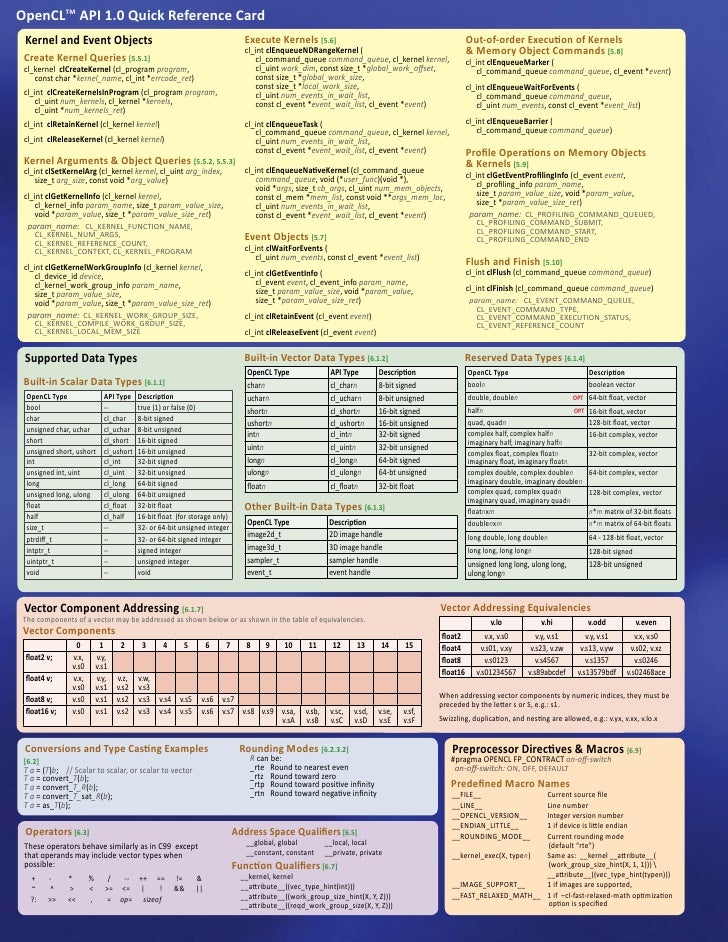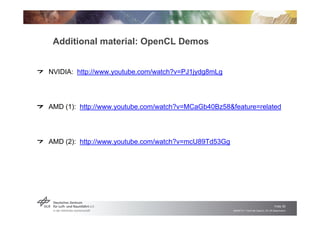

- #Opencl benchmark example mac os x#
- #Opencl benchmark example drivers#
- #Opencl benchmark example pro#
The CPU benchmark measures memory copy bandwidth, that is, how fast the CPU can move data in the system memory from one place to another. It is also called Device-to-Device Bandwidth. Measures the performance of the GPU's own device memory, effectively measuring the performance the GPU can copy data from its own device memory to another place in the same device memory. The CPU benchmark measures memory write bandwidth, that is, how fast the CPU can write data into the system memory. It is also called Host-to-Device Bandwidth. Measures the bandwidth between the CPU and the GPU device, effectively measuring the performance the GPU can copy data from the system memory into its own device memory. The CPU benchmark measures memory read bandwidth, that is, how fast the CPU can read data from the system memory. It is also called Device-to-Host Bandwidth. Measures the bandwidth between the GPU device and the CPU, effectively measuring the performance the GPU can copy data from its own device memory into the system memory. The CPU benchmarks are heavily multi-threaded, and are optimized for each CPU architecture introduced since the first Pentium.Ĭurrently, the following benchmark tests are available: Memory Read These CPU benchmarks are very similar to the old AIDA64 CPU and FPU benchmarks, but this time they measure maximum computing performance (FLOPS, IOPS). However, the CPU benchmarks do not use OpenCL, but are written in native x86/圆4 machine code, utilizing available instruction set extensions such as SSE, AVX, AVX2, FMA and XOP. For the compilation, the following OpenCL compiler options are passed: -cl-fast-relaxed-math -cl-mad-enable.įor comparison purposes, the GPGPU Benchmark Panel offers CPU measurements as well.
#Opencl benchmark example drivers#
Because of this, it is always recommended to have all video drivers (Catalyst, ForceWare, HD Graphics, etc.) updated to their latest version. The OpenCL kernels used for these benchmarks are compiled in real-time, using the GPU's OpenCL driver. Instead, the AIDA64 OpenCL module relies on the OpenCL compiler which optimizes the OpenCL kernel to run best on the underlying hardware. Basically, any computing device that is listed as a GPU among the OpenCL devices will be benchmarked.Ĭurrent OpenCL benchmarks are not optimized for any GPU architecture. Of course, CrossFire and SLI configurations as well as both dGPUs and APUs are fully supported. Currently, there is only preliminary support for HSA configurations. Each individual benchmark can be run on up to 16 GPUs, including AMD, Intel and NVIDIA GPUs, or the combination of these. These are designed to measure GPGPU computing performance using various OpenCL workloads. Intel Core 2 Duo 2.40GHz: 15.459 secondsĬombining all three processors at once could theoretically deliver substantial performance improvements to the right application.įinally, another floating point benchmark application called AO Bench has also been ported to OpenCL and can also show the difference between CPU and GPU performance in some configurations.This benchmark panel, which can be launched from Tools | GPGPU Benchmark, offers a set of OpenCL GPGPU benchmarks.
#Opencl benchmark example pro#
In this particular example, the benchmark performance of the user's MacBook Pro CPU and two discrete GPUs were as follows (smaller numbers faster):


#Opencl benchmark example mac os x#
In contrast, both of these GPUs can not be used for general graphics processing and requires a Mac OS X logout to switch from one to another. Most interesting is that for owners of high end MacBook Pros which contain both 9400M and 9600M GT graphics cards, both GPUs can be used at any time by OpenCL. The benchmark runs on each device showing the relative performance. NVIDIA GeForce 9400M, GeForce 9600M GT, GeForce 8600M GT, GeForce GT 120, GeForce GT 130, GeForce GTX 285, GeForce 8800 GT, GeForce 8800 GS, Quadro FX 4800, Quadro FX5600 The current list of OpenCL supported GPUs include: Forum user J the Ninja, however, points to a recently released OpenCL Benchmark application that tests the speed of the various OpenCL capable devices in your Mac. Unfortunately, there have been few apps that have been released that properly demonstrate the potential of OpenCL. This would allow powerful graphics cards (GPUs) to do more general processing and could improve application performance substantially. OpenCL is a framework that allows applications to more easily harness the power of multiple GPUs and CPUs found in your computer. With the release of Mac OS X Snow Leopard, we're getting our first look at the possibilities behind Snow Leopard's OpenCL technology.


 0 kommentar(er)
0 kommentar(er)
